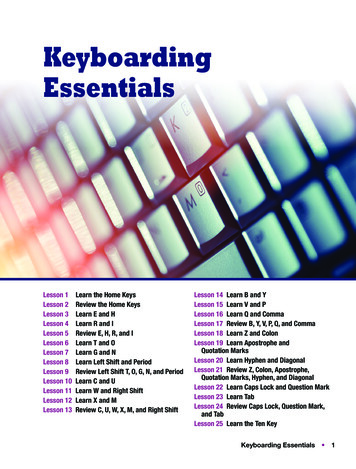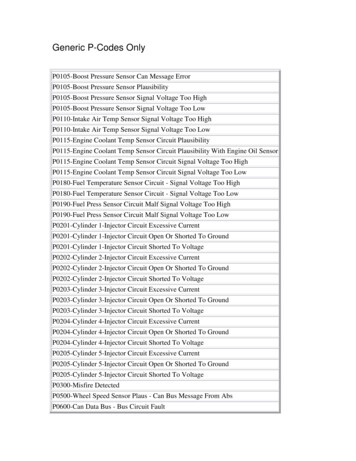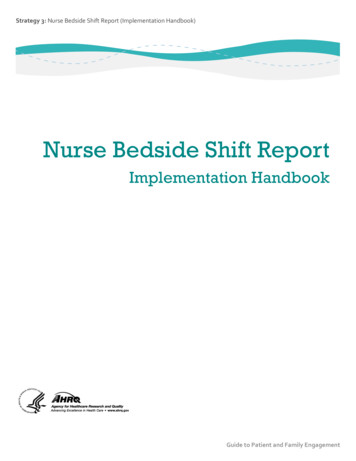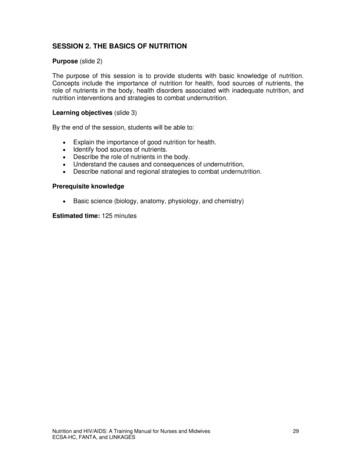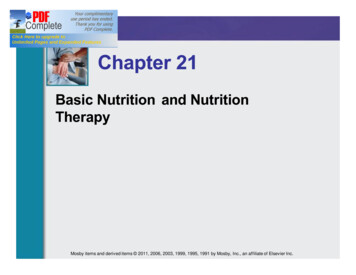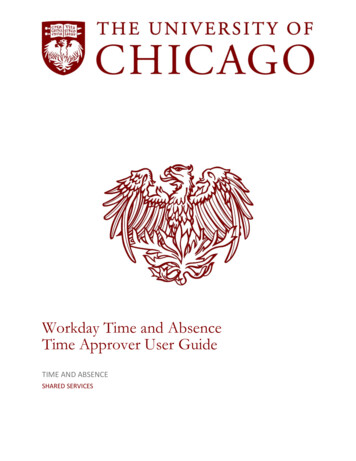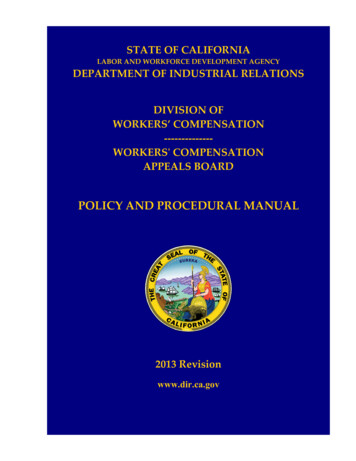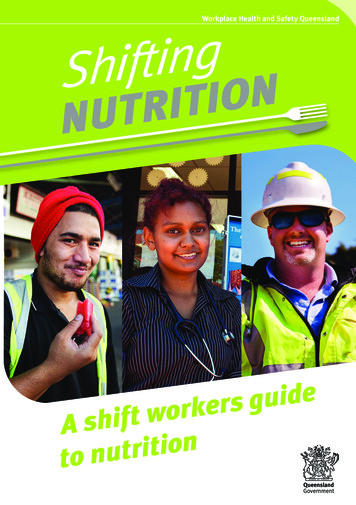
Transcription
Workplace Health and Safety QueenslandgnitfiShONITIRNUTediugsrekrowtfiA shnoitirtunto
ShiftingnutritionWorking shifts can impact on the way you eat and the types of foods anddrinks you consume. Having a healthy diet is not only important for yourlong-term health and preventing chronic diseases, but it is also essential formaintaining your body’s day-to-day function and energy levels. This bookletprovides practical information to help you to make the right choices aboutwhat you eat - helping you to shift your nutrition and ensure you are eatingthe right foods, at the right time.What happens to your body when you work shifts?Your body has a 24 hour cycle (also known as your body clock) that helpsto regulate when you wake-up, your digestion, hormones and many otherfunctions of your body. This inbuilt clock is pre-programmed to respondto you being active during the day and asleep at night, so when you workshifts, your body can find it difficult to adjust.When your body clock is disrupted, you may begin experiencingdisturbances to your sleep, fatigue and potential health problems.However, eating healthy foods at the right time can make shift workeasier by providing your body with energy when you need it, assisting youto sleep better when you rest and helping to prevent fatigue.Why shift your nutrition habits?Poor eating habits combined with a lack of physical activity can put youat a greater risk of developing chronic diseases including type 2 diabetes,heart disease and some cancers.Research shows that shift workers, especially males, are at an even greaterrisk of developing type 2 diabetes.By eating well, maintaining a healthy weight and exercising regularly, youcan decrease your risk, delay or even prevent the onset of type 2 diabetes.Assess your risk today with a quick and free risk assessmentat diabetesqld.org.au2
Healthy eatingguidelinesfor shift workersEnjoy a wide variety of nutritious foods from the fivefood groups every day.Aim to maintain a regular eating pattern,regardless of your shift: Eat every three to four hours: aim for three main meals and twoto three snacks in a 24 hour period Eat according to the time of day: breakfast foods in the morning, lunchfoods in the middle of the day and dinner foods in the evening Late at night, eat snacks that contain protein instead of a large mealat a time when you would normally be sleeping Eat a small meal after your shift so you don’t go to bed hungry Watch your portion sizes – make sure you don’t overeat.Choose healthy drinks: Drink plenty of water Limit your intake of sugary drinks, alcohol and caffeine Avoid caffeine at least 6 hours before sleeping.3
Food termsexplainedProteinProtein is the body’s building block for muscle,cartilage, skin and blood and helps to keep youstrong and healthy. Protein rich foods also help tokeep you feeling fuller for longer. Foods high inprotein include meat, fish, poultry, tofu, eggs, nutsand beans.CarbohydratesCarbohydrates are the body’s primary fuel sourceand provide energy to the brain, muscles andother organs. Foods that contain carbohydratesinclude wholegrain breads, cereals, rice, pasta,noodles, most fruit and some dairy foods.Glycaemic Index (GI)All carbohydrates are given a GI score. This is ameasure of how quickly the body can convert thefood into energy. Low GI foods are the healthiestoption as they provide longer lasting energy. LowGI foods include brown rice, grain bread, pastaand most fruits and vegetables.FibreFibre helps to keep everything you eat movingthrough your digestive system, keeping it healthy.Foods high in fibre include wholegrain breads andcereals, fruits and vegetables.4
Planningyour mealsDay shiftWhen you wakeBreakfast meal to provide you with energy for your day.During your shiftLunch meal and snacks to keep you alert and energised.After your shiftDinner meal (small meal if immediately before sleeping) to help you sleepand stop you from waking due to hunger.Night shiftAfter your shift and before sleepingSmall breakfast to help you sleep and stop you from waking due to hunger.After your sleepLunch meal to provide you with energy for your day.Night time meal breaksEarly in your shift: small dinner meal or snack.Late in your shift: a small snack every few hours to keep you alert andenergised.RememberAll meals should include a balance of protein, low GI carbohydratesincluding fruits and vegetables. See page 8 and 9 for some healthy shiftwork food ideas, or head to the Healthy Shopping website:diabetesqld.org.au/healthy-shopping5
Australian Guide to Healthy EatingEnjoy a wide variety of nutritious foodsfrom these five food groups every day.Drink plenty of water.Grain (cereal) foods,mostly wholegrainand/or high cerealfibre varietiesVegetables Red kidneybeansWheat flakesRed lentilsChickpeasRed kidneybeansLentilsMixed nutsChickpeasFruitLean meats andpoultry, fish, eggs,tofu, nuts and seedsand legumes/beansMilk, yoghurt, cheese and/oralternatives, mostly reduced fatUse small amountsOnly sometimes and in small amounts
Eat forgood healthThe Australian Guide to Healthy Eating shows the foodswe should be eating every day from each of the five foodgroups. It also shows that certain foods should only beeaten sometimes and in small amounts. These include foodsthat are high in saturated fats, sugar and salt, such as ‘junkfoods’, fast food and sugary drinks.A healthy dietincludes: Plenty of vegetables Grain foods - mostly wholegrain Lean meats and poultry, fish, eggs,tofu, nuts and seeds and legumes/beans Fruit Milk, yoghurt cheese and/oralternatives, mostly reduced fat.The exact amount of food you need to eat depends on yourage, gender, height, weight and how much physical activityyou do. See the Australian Guide to Healthy Eating websitefor further information: eatforhealth.gov.au7
Shift yourfood ideasBreakfast ideas: Wholegrain breakfast cereals such as rolled oats, muesli,wheat biscuits or bran cereals with milk and fruit Wholegrain toast, sandwich or wrap with toppings such as bakedbeans, eggs, cheese and tomato, banana and honey, baby spinach andavocado Breakfast cereal drink and a piece of fruit Homemade mini quiche or vegetable slice.Don’t skip meals as you are more likely to overindulgethe next time you eat.Snack ideas: Fruit – fresh or pre-packaged. Try addingyoghurt, rolled oats or nuts and seeds Wholegrain crackers with a tin of tunaor baked beans Natural nut mix or air poppedpopcorn Vegetables sticks with dip suchas avocado, hommus, tzatzikior peanut butter Fruit toast or homemadevegetable or fruit muffin Smoothie or bowl ofbreakfast cereal.8
Eat for energy - avoid junk foods as they will makeyou feel sluggish.Lunch and dinnerideas: Homemade burger or pizzawith vegetable toppings Spaghetti bolognaise –include grated vegetablesin sauce Vegetable and bacon quichewith salad Burritos or tacos with salad Lean protein and vegetablestir fry Lean protein and vegetablecasserole Frozen microwave steamfresh fish with vegetablesand rice.No access to a fridge?There are plenty of healthy options you can take with you when youdon’t have access to a fridge. Have a look at the meal ideas above andget creative – try freezing your yoghurt and meals, putting soup orcasserole into a large thermos or freezing sandwiches. Remember tostore food safely – keep cold foods cold by using an esky or cooler bagwith a frozen ice block or frozen water bottle in it.9
What does yourplate look like?Check the size of your plate. Eating from a smaller plate can trickyour brain into thinking the meal is bigger than it is.What’s for dinner?Fill 1/2of yourplate withcolourfulvegetablesTry stir frying,steaming, androasting. Addvegetables toyour casseroles,curries, saucesand mincedishes.Fill 1/4of yourplate withleanproteinFill 1/4 of your plate withstarchy vegetables orwholegrain foods.Trim fat frommeat. Chooselean mince.Chose skinlesschicken. Includeplant proteinfrom legumesand tofu.Now mix it upThe What’s for dinner poster (2015) was originally produced by NAQ Nutrition and hasbeen reproduced here with permission. Visit www.naqld.org for more information.10
What’s inyour drink?Water is the best choice of drink. Aim to drink two litres ormore a day depending on the temperature and how activeyou are. Try adding fresh herbs like mint or fruit such aslemon, lime or strawberries for a natural flavour. Reduced fatmilk and 100% juice are also healthy choices when consumedin moderation.Need another reason torethink sugary drinks?Teaspoons of sugar: 600ml cola 16 teaspoons600mlSoftDrink 500ml energy drink 13 teaspoons 600ml iced coffee/chocolate 13 teaspoons 600ml sports drink 9 teaspoons 500ml iced tea 6.5 teaspoons 500ml vitamin water 6.5 teaspoons 250ml fruit drink 6.5 teaspoons 250ml cordial 4 teaspoons.500mlEnergyDrinkIf you drink one 600mlsugary drink every day, youwill consume a whopping 22kilograms of sugar in one year!11
Healthytakeaway tipsTakeaway foods can zap your energy and leave you feeling flat. Theyare often high in salt, fat and sugar, and can contribute to excessweight gain and lifestyle diseases like type 2 diabetes. If takeaway isthe only option available, choose wisely and make a healthy choice.No matter what type of takeaway store you visit, be sure to choosean option containing vegetables or salad, or ask to add a side serveof these. Don’t be tempted to upsize or add extras like hot chips orsoft drink and remember water is the best choice of drink!If you are on the road or travel as part of your work, packsome healthy snacks such as trail mix, fruit and tinnedtuna or beans.12
Takeaway store Ditch deep fried foods for meat skewers, rice paperrolls or steamed dim sims Choose dishes packed with vegetables like salads, stirfries and soups. Avoid creamy curries or sauces Ask for thin and crispy or regular base pizza. Limit highfat toppings like salami, pepperoni and extra cheese Avoid burgers or sandwiches with fried onions, bacon,extra cheese and creamy dressings like mayonnaise.On the road Avoid the hot box, hot chips and junk foods Look for meat and salad sandwiches or burgers No healthy meals available? Look for fresh or cannedfruit, yoghurt, trail mix or nuts, tinned beans, tuna orspaghetti.At the pub Don't feel pressured to eat everything on your plate.Choose an entree or share a meal with a mate Ask to change the side of chips to a side of salad orvegetables Avoid deep fried options such as fish, calamari andcrumbed chicken Avoid creamy sauces and dressings or ask for themon the side.At the onsite cafeteria Watch your portion sizes - don’t overload your plate Avoid the bay marie and fried foods Choose dishes with lots of vegetables like salads, stirfries and casseroles Re-think dessert. Remember these are occasional foods.13
PlanningaheadBeing organised is the key to eating well on shift. Setyourself up for success by planning your meals for the shiftsahead, going grocery shopping and completing some mealpreparation.Try buying: Zip lock bags and small reusablecontainers so you can portion outmeals and snacks Frozen mixed vegetables or individualvegetable steam bags Pre-packaged fresh vegetable andsalad mix bags Tins of tuna, chicken or baked beans Frozen microwave steam fresh fish Single serve microwave rice, quinoaor pasta packets Single serve microwave tubs of soup Ready to eat frozen or fresh meals.Cook recipes in bulk andfreeze leftovers in single serveportions.14
Shiftyour thinkingShifting your nutrition isn't that hard. Remember theseguideline to help you stay on track!Aim to maintain a regular eating pattern,regardless of your shift: Eat every three to four hours: aim for three main meals and twoto three snacks in a 24 hour period Eat according to the time of day: breakfast foods in the morning, lunchfoods in the middle of the day and dinner foods in the evening Late at night, eat snacks that contain protein instead of a large mealat a time when you would normally be sleeping Eat a small meal after your shift so you don’t go to bed hungry Watch your portion sizes – make sure you don’t overeat.Choose healthy drinks: Drink plenty of water Limit your intake of sugary drinks, alcohol and caffeine Avoid caffeine at least 6 hours before sleeping.15
The workplace can also play an important role in yournutritional choices. For useful ideas and tools to support healthy eating in yourworkplace visit worksafe.qld.gov.au and download a copy of the 'Employers guideto shifting nutrition'.Other useful resources include:Workplace Health and Safety eDiabetes QueenslandPhone: 13 74 75Helpline - 1300 136 es Queensland is a charity supporting all people with diabetes and those at risk.Get Healthy Qld:gethealthyqld.com.auMy Health for Lifemyhealthforlife.com.auNAQ Nutritionnaqld.org.auAdditional food guidelines and nutritional resources.Diabetes Queensland would like to thank Queensland University of Technology,NAQ Nutrition and Pacific National for their contribution to this bookletOriginally developed by Diabetes Queensland in partnership with Workplace Healthand Safety Queensland as part of the State Government funded Healthier. Happier.InitiativeThe material in this publication is distributed by the Queensland Government for information only and is subject tochange without notice. The Queensland Government disclaims all responsibility and liability (including liability innegligence) for all expenses, losses, damages and costs incurred as a result of the information being inaccurate orincomplete in any way and for any reason. State of Queensland 2020.
foods’, fast food and sugary drinks. A healthy diet includes: Plenty of vegetables Grain foods - mostly wholegrain Lean meats and poultry, fish, eggs, tofu, nuts and seeds and legumes/ beans Fruit Milk, yoghurt cheese and/or alternatives, mostly reduced fat.
